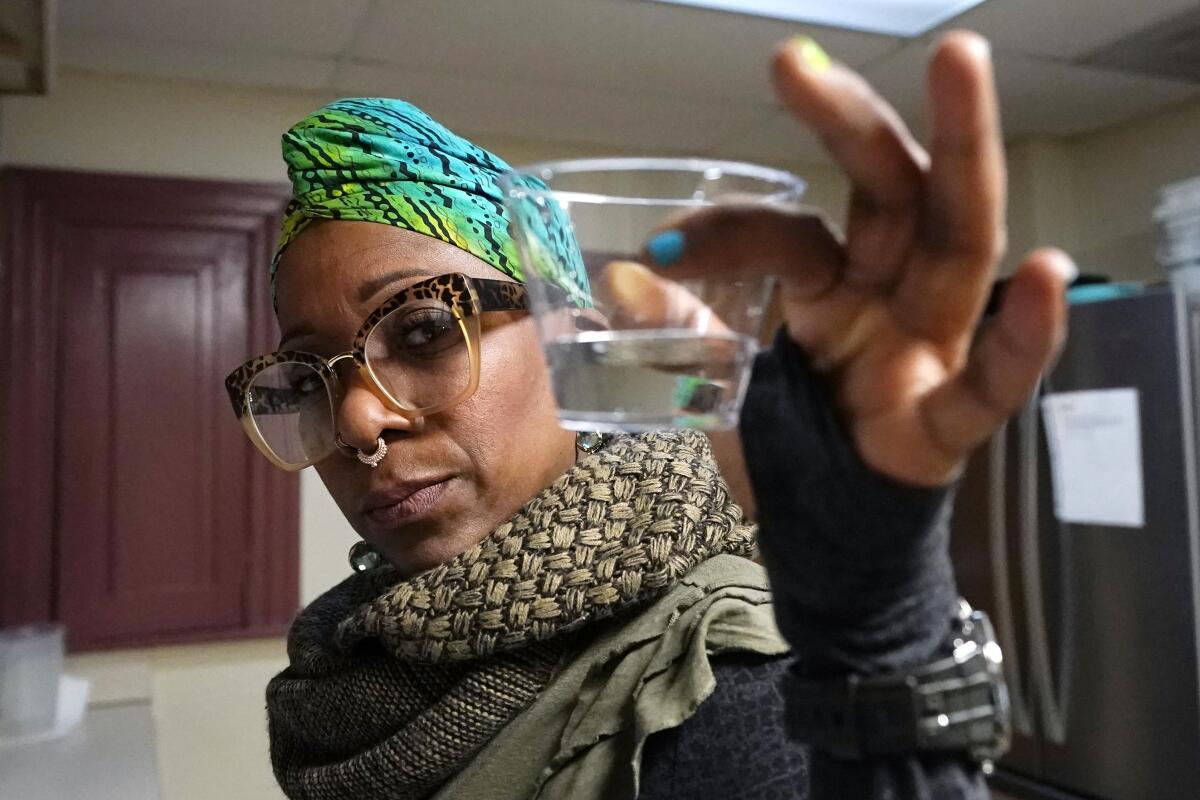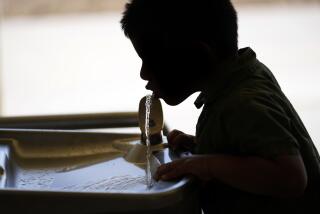U.S. pushes for better tap water but must win over wary public

ST. LOUIS — Angela Stamps won’t drink water from her faucet, showers less and no longer takes the baths she once found relaxing. She doesn’t cook with tap water and sometimes skips rinsing her produce.
Even though the amount of lead in Flint, Mich.’s tap water has been well below a key state threshold for several years, she hasn’t been able to stop worrying since going through the trauma of the city’s lead crisis.
“I just don’t trust it,” she said.
As the Biden administration looks to spend billions of dollars to address inequalities in water quality and access, officials must try to overcome persistent public distrust of tap water. Experts say it will be especially difficult to overcome in Black and Latino communities, where suspicion can be entrenched because of past instances of being misled by public officials and high-profile lead crises in cities with large Black populations, including Flint and Newark, N.J.
“Problems in one place erode trust in other places,” said David Switzer, a water quality and public policy researcher at the University of Missouri.
The issue will hit home in many cities and towns as the Biden administration pushes to replace millions of lead service lines in the U.S. that can leach lead into drinking water. In addition, tightened testing standards might reveal higher lead levels and put more communities on notice about problems.
The guardrails of democracy are still vulnerable after Trump’s attempt to shred them. It’s time for Congress, Biden and Merrick Garland to shore them up.
Lead exposure can cause a host of health problems and is considered especially dangerous for young children because it can slow development and cause other troubles.
Already, 20% of adults nationally say they don’t drink tap water — filtered or not — up from 14% before the Flint crisis, according to a study of federal survey data. The figures are higher among Black adults, with 35% saying they avoid drinking tap, up from 25% before Flint. Among Latino adults, the figure rose to 38%, up from 27%.
That distrust can translate to unnecessary spending on bottled water or make it more likely that adults reach for sugary drinks that can increase the risk of health problems such as diabetes and cavities, said Asher Rosinger, a Pennsylvania State University researcher who studies water access.
There’s also the constant stress for parents who worry that tap water might poison their children, he said.
Though the vast majority of the country’s water systems report that they meet federal health standards, problems such as elevated lead levels and health violations happen more often in lower-income areas that are predominantly Black or Latino, Switzer said.
Defective plumbing that tinges water brown or creates an odd taste can also turn people away from the faucet. Immigrants from countries with unsafe water might transfer that distrust to water that might be safer in the U.S. and pass that uneasiness on to their children, said Silvia R. González, who works on environmental equity and water issues at UCLA’s Latino Policy and Politics Initiative.
“Thinking about my family, my dad will not drink the tap water, and therefore my brother does not drink the tap water,” said González, whose father immigrated to the U.S. from Mexico.
And if residents feel their local government is indifferent to their needs — a problem especially prevalent in Black and brown communities — that can foster distrust in drinking water, according to experts.
“There’s a legacy of mistrust and a healthy sense of paranoia that has kept us alive for centuries,” said Robert Bullard, a professor at Texas Southern University who has researched and pushed for environmental justice for decades.
Philadelphia, which is 44% Black, is one of the few places that have run a public campaign to help save residents money and reduce plastic pollution by boosting trust in tap water. Murals on buildings and songs promote the city’s drinking water.
Though the city hasn’t had a lead scandal, its surveys indicate that residents avoid the tap because of health concerns and taste. Among Black residents in 2021, more than 60% said they mostly drank bottled water, compared with 42% of Philadelphia’s residents overall.
Monika Davis, who is Black, switched from bottled water to tap when she applied to become one of roughly a dozen residents enlisted by the city as ambassadors in 2019 to show up at events and talk to her neighbors about the safety and benefits of tap water.
She remembers her family boiling water as a precaution when she was growing up. Touring the water treatment plant and learning about the city’s water quality helped convince her of its safety, she said.
The percentage of residents relying on bottled water declined after the campaign, but it rose again last year.
“It takes a lot to change a habit,” Davis said.
For some, the Flint crisis reinforced suspicions that public officials are indifferent to Black and brown communities. Michigan officials had switched the city’s water source to save money and initially downplayed the problem before the facts emerged and it became a major scandal.
“People rightly felt betrayed,” said Mark Edwards, a water quality specialist at Virginia Tech.
The Centers for Disease Control and Prevention says no amount of lead is considered safe for children. But many water systems have some lead and are required to take significant action when levels reach a federal threshold. Edwards said the CDC guidance might cause needless fear, muddling the difference between low levels and amounts that are truly concerning. Flint’s levels are low but not zero.
Stamps cites the federal health goal of no lead to explain her skepticism, saying none should be in the water.
It’s why experts say that it won’t be enough to replace lead pipes and that public outreach efforts will be key.
In Flint, Michigan officials say lead levels have been lower for years and the state now has the strongest lead water protections in the country. They say they have worked to replace lead lines, upgrade infrastructure and be transparent by publishing testing data, but they acknowledge that rebuilding trust will take time and continued outreach.
A community lab that isn’t affiliated with the government also tests water for free.
“The residents are still at a point where they are not trusting government,” said Candice Mushatt, the Flint Community Lab’s director, adding that residents value the lab’s independence — it builds trust.
More to Read
Sign up for Essential California
The most important California stories and recommendations in your inbox every morning.
You may occasionally receive promotional content from the Los Angeles Times.











